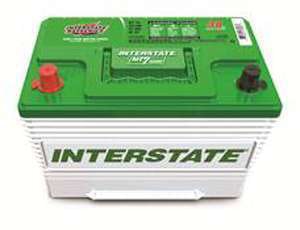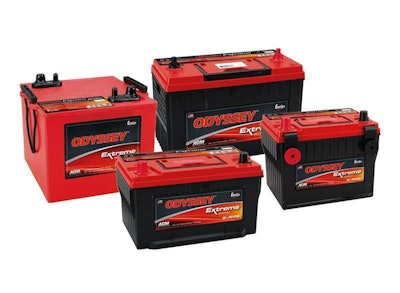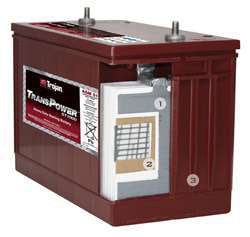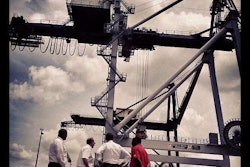 Johnson Controls says its Eveready Gold AGM 31 batteries are designed to address today’s heavy-duty vehicle needs.
Johnson Controls says its Eveready Gold AGM 31 batteries are designed to address today’s heavy-duty vehicle needs.New rules and regulations in the trucking industry are placing heavier demands on electrical systems, and in some cases, conventional battery designs are unable to meet the increased hotel loads placed on trucks – particularly on long-haul sleepers with auxiliary power units and other anti-idling equipment.
Some battery makers believe absorbed glass mat (AGM) technologies may be a solution. AGM batteries technically aren’t new: They were developed in the early 1970s, but over the past several years they have made inroads in heavy-duty vehicle applications due to their deep discharge rates, ability to withstand extreme temperatures and lower maintenance demands.
 Interstate Batteries’ MT7 AGM battery is designed to accommodate the cycling demands for drivers who plug in additional devices such as cellphones, backup sensors and GPS navigators.
Interstate Batteries’ MT7 AGM battery is designed to accommodate the cycling demands for drivers who plug in additional devices such as cellphones, backup sensors and GPS navigators.“Battery selection today really comes down to the demands of the specific application the vehicle operates in,” says Dr. Joe Liedhegner, manager of customer support for Johnson Controls. “In automotive applications, the battery’s main job is to crank the engine. Once that’s done, the vehicle’s electrical system takes over.”
 Odyssey batteries feature EnerSys’ Thin Plate Pure Lead technology designed to allow a faster recharge.
Odyssey batteries feature EnerSys’ Thin Plate Pure Lead technology designed to allow a faster recharge.Liedhegner says those standards still apply to daycabs that don’t require deep discharge. But with long-haul trucks, “we’re seeing a growing need for a heavy-duty battery that now has much deeper discharge cycles because they do so much more than just start the engine,” he says. “You’re really exercising the full range of the battery and its capabilities, and fleets are starting to understand they need a battery designed to handle those applications.”
As onboard technologies change and electrical advances in heavy-duty applications are introduced, it becomes critical to select the right battery for a specific application. While both flooded and AGM batteries are used in trucking, the latter is becoming an accepted technology to meet the vehicle’s demands.
Brad Bisaillon, Trojan Battery’s sales manager for strategic accounts and transportation, says flooded batteries are suitable for vehicles with minimal technology or in applications where batteries are not exhausted by long-term use of advanced electrical operations, while AGM batteries are best for over-the-road applications that typically put more demands on the vehicle’s electrical systems.
“Deep-cycle AGM technology is designed to withstand the rigorous demands put on these batteries that flooded technology can’t handle,” Bisaillon says. “Trucking fleets are quickly realizing that a well-designed AGM battery can provide a broad array of advantages such as longer life, more run time and less maintenance.”
 The Trojan Battery TransPower ST1000 is a sealed maintenance-free AGM 31 heavy-duty starting battery with 1,000 cold cranking amps of power.
The Trojan Battery TransPower ST1000 is a sealed maintenance-free AGM 31 heavy-duty starting battery with 1,000 cold cranking amps of power.Maria Orlando-Krick, marketing manager of specialty markets for EnerSys, says fleets experiencing problems with conventional flooded batteries should consider an absorbed glass mat/valve-regulated lead acid (AGM-VRLA) battery, which is sealed and eliminates the need to refill the electrolyte while avoiding corrosion of the positive terminal and its surrounding area.
Such batteries also perform well with parasitic loads, Orlando-Krick says. “Usually, if a battery is overdischarged or the vehicle is not in operation for a long time, the battery will get deeply discharged by the small current drains from parasitic loads,” she says. Odyssey batteries feature EnerSys’ Thin Plate Pure Lead (TPPL) technology designed for a faster recharge, which helps the batteries tolerate frequent discharges.
“We definitely see AGM batteries alleviate many of these issues, but you do have to take into account how severe your application is,” Liedhegner says. “As vehicles continue to electrify, fleet managers need to be careful in monitoring key offloads and educating drivers about battery life.”
Common items inside a cab draw more power than one might think: Some GPS systems and LED TVs have heavy drains if they’re left on overnight. “If managed correctly, we typically see up to twice the life from an AGM battery than a flooded battery depending on the application,” Liedhegner says.
However, the extra power and durability provided by AGM batteries comes with higher upfront costs than those of conventional flooded batteries. “While the upfront cost may be slightly higher, high-quality batteries will pay for themselves in the long run with fewer premature battery failures,” Bisaillon says.
Fleets intent on saving money by spec’ing lower cycle-life batteries actually might spend more money in the long run due to frequent battery replacements and downtime.
“Bottom-line profits are the primary goal for any company, so investing in quality AGM batteries and properly maintaining them equates to more time on the road and less time in the shop,” Bisaillon says.









